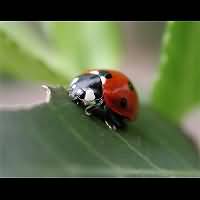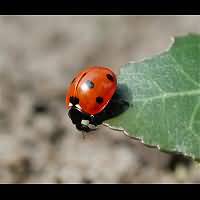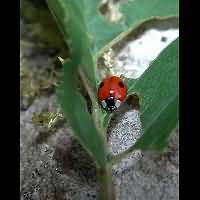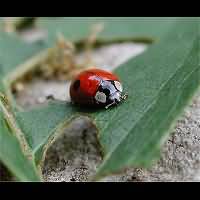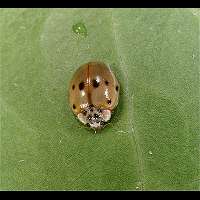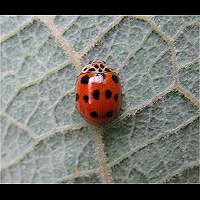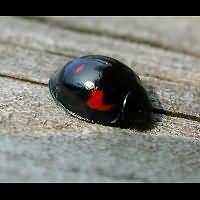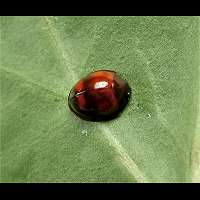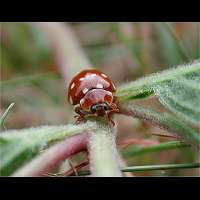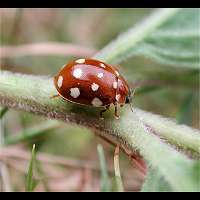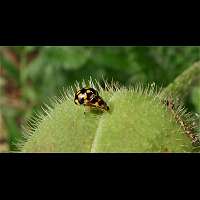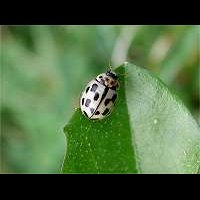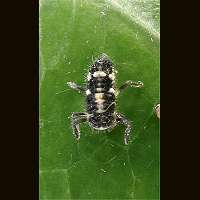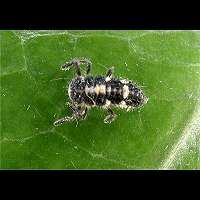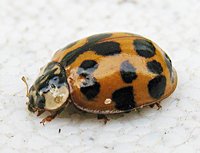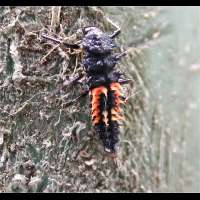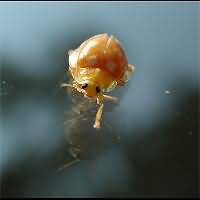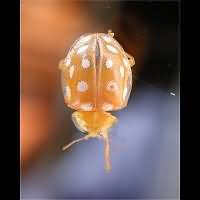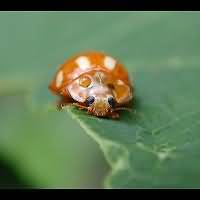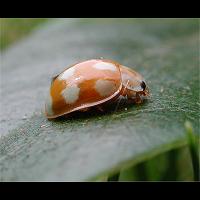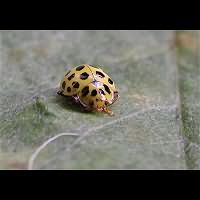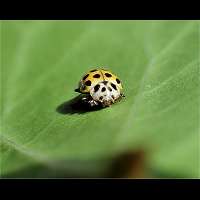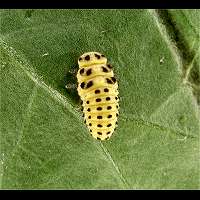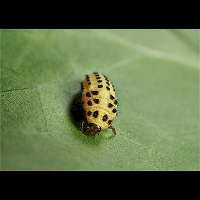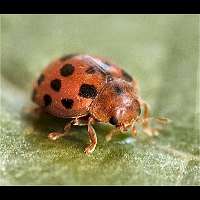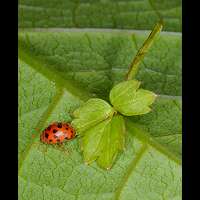[All pictures of garden wildlife on this page are thumbnails. Click on any thumbnail for a large format to be displayed.]
Lady Beetles (Coccinellidae)
Lady birds (or Lady Beetles, sometimes even called Lady Bugs) are beetles that are very easy to identify: small, round bodies and usually red with black spots or the other way around. Perhaps they are the insects most people like best. Who hasn't been playing with these creatures being a child? Just put one on your hand, point upwards and the little creature, trying to find the highest point, will be running to the top of your finger, where it will expose its wings and fly off. Probably they have always been populair in Europe, for there is a Christian touch to their names in other languages as well: lieveheersbeestje (good lord beetle) in Dutch and Marienkäfer (Maria beetle) in German. There are many more species in this family than most people realize. Most species can be identified by counting the dots on the shields. Those dots do not tell you what age the animal is (usually they live for just one year or shorter), but are good clues for naming the species. However one should be very careful, for there are a few species which are extremely variable. One of the most common species, the Two-spotted Lady Beetle, for instance is red with two black dots in its typical outfit. But some have more than just two black dots and the black dots can even be connecting, thus looking like dark stripes, hooks or lines. On the other hand the basic colour may be black instead of red. Some have two black dots on the red shields, but others might have four or even six black dots! Ladybirds all have colours to warn off predators. Colours like combinations of red and black or yellow and black are typical warning colours, just like in let's say wasps. And it works, for you will never see a bird eating a Ladybeetle, for they have a very bad taste and are slightly poisonous. When threatened many species will produce a drop of a smelly, yellowish and extremely untasty liquid, usually enough to scare away the attacker. We have divided the Ladybugs into three groups: first a very useful group, especially in ones garden: species eating aphids (plant-lice). These species are always red with black dots or the other way around. The second group consists of fungus eaters. These species are usually yellow or orange with black or white dots. Some species are harmful in the garden, especially those eating mildew. Parts of the fungus or the spores attach themselves to the feet of the beetle. When it flies off to another plant the parts or spores will be released. This way the beetles are unwillingly spreading the mildew around all over the garden. The third group is very small and consists of vegetarians.
Contents: 1 Aphid Eating Ladybeetles, 2 Fungus Eating Ladybeetles, 3 Vegetarians.
![]()
One of the most common Ladybugs is the Seven-spotted Lady Beetle, often referred to as the Sevenspot or the Sevenspotted Ladybird. Not very difficult to identify, for it is a typical ladybeetle, red with black spots and the total number of spots is seven. The seventh spot runs on both shields and just in front are two small white triangular shaped dots. Like all other ladybirds eating aphids they don't real track them down, they simply stuble over them. The adults can be seen from March to November mainly, but in winter some remain active. The size is typical for members of this family: some 6 to 8 mm. The larvae are blue with some pink spots. They are often found near an aphid colony, eating the sap suckers one by one. But, given the opportunity, they will be eating other small insects as well. You may also see ants chasing the larvae away. Nowadays this species is used commercially to fight aphid infections on plants, just like the Two-spotted Lady Beetle and some Green Flies.
Two fine pictures of the Seven-spotted Lady Beetle (Coccinella septempunctata).
The 2-spotted Ladybird, also referred to as Two-spotted Lady Beetle and, especially in the USA, Two-spotted Ladybird Beetle, is a very variable animal in colouring. It could be red, orange, yellow or black, often with 2 spots, but actually any number of spots can be seen irregularly and sometimes the spots are not visible at all! In northern parts of Europe, Asia and Canada the animals tend to be all black. As black is the best colour to absorb sunlight, black is the best colour to warm up quickly. The animal is very common all over Europe and its territory covers even more northern regions than that of other ladybirds. Both adults and larvae eat aphids. Compared to the Seven-spotted Ladybird above this species is smaller, reaching a length of 4 to 6 mm. The adult beetle overwinters and is often found in garages, cellars and attics. Sometimes it even tries to overwinter in bedrooms and livingrooms. The low humidity and high temeratures in those rooms usually kills it due to dehydration. Most popular species among the lady beetles for biological agriculture. The larvae can be bought on the internet and in specialized shops.
Commercially of great interest is the Two-spotted Ladybird (Adalia bipunctata).
The 10-spot Lady Beetle is even more variable than the Two-spotted one above. It is about the same size (4 to 5 mm), but can be a very difficult one to identify at times. Sometimes there is an additional dot on the edge of the shields. This makes you count 11 dots. The one in the picture below is a common varietyas well: the spots on the last part of the shields are missing, hence you count only 8 spots. Besides: it takes this species a long time to reach its final red colour, if ever. So many specimens are brownish, pale red or orange. Brownish animals often have creamy white spots instead of the well known black spots. And if that isn't enough there are melanistic animals: black with red or creamy spots. But except for the melanistic forms all animals share a common factor: the neck shield is white with four black dots or blobs, neatly arranged like in a circle around a fifth black spot in the middle. The animal is fairly common on the continent as well as in Britain, but a rarity in our garden. Only two popped up so far, and that's why we can't show you a lot of varieties of this species.
The 10-spotted Ladybird (Adalia decempunctata) is closely related to the Two-spotted one above and just as variable.
For quite some time we thought the animal below was just one of the variations seen in the Two-spotted Ladybird. Luckily Bertin Boertjes corrected us. This is the Pine Ladybird. It too is quite variable, but usually it can be told apart from variations of the 2-spot by examining the front set of spots. These ordinarily are shaped like (part of) a horse shoe. Commonly the animal is black with two red dots, but the dots, especially the rear ones can be yellow as well. Sometimes one might come across animals that are yellow all over! Below to your left a typical animal, but to the right an animal that might be another species alltogether, but still is a Pine Ladybird too. It is perhaps one of the most rounded of all ladybirds. Reaching some 3 to 5 mm. only it is one of the smaller species too. This ladybug is very common, but only when pines are around. In many gardens though this species will be very scarce indeed. The larvae especially are very interesting, for not only do they eat aphids, but scale insects as well. Scientifically this animal used to be known as Exochomus quadripustulatus untill recently.
Probably not a common species in most gardens: the variable Pine Ladybird (Brumus quadripustulatus).
The Cream-spotted Lady Beetle below also belongs to our most common species. Yet it is not often seen, for it lives high up in trees. Occasionally it inhabits lower shrubs and plants. The adults are seen almost all year round, for they overwinter. Best chances of seeing this species is in autumn, when it regularly falls down with leaves and is seen climbing back to trees. The spots are almost invariably arranged the same way. In total each shield has seven of them: one in the front, followed by three, usually almost in a stright line. Next are two dots and a single spot makes the number seven. The species is quite variable when it comes to size though: small ones may be just 4 mm, big ones 6 mm. Both the adults and the larvae eat aphids and such.
Because it lives high up in trees, this very common species, the Cream Spotted Lady Beetle (Calvia quatuordecimguttata), is not often seen.
Below one of the Ladybirds showing square rather than round dots: the 14-spot Ladybird. Often one or more of the dots have merged. The basic colour may vary as well from white to deep yellow. The pattern of the black blob on the neck shield is variabel as well, but in almost all cases the basic colour is white and except for the big black blob there are no small dots to be found. Reaching 4 to 6 mm this is one of the bigger Lady Beetles. A common species in meadows and the edges of woods. The adult beetle may reach the respectable age of 2! Scientifically also known as Propylea 14-punctata.
The adult of the 14-spot Ladybird (Propylea quatordecimpunctata) may well live for two years. It is a very variable species too.
In 1996 the 14-spot was discovered in a potato field in the USA. It is an invasion species over there and said to influence the native species negatively. The same is said of the Asian Lady Beetle, which has been found in many parts of Europe and was discovered in the USA in 1995. Anyway, the larva of the 14-spot Ladybird is quite an ugly thing. Still one recognizes the typical ladybird shape of this larva immediately. Like many other ladybird larvae it is very active, a good runner and mobile. The larva is used commercially to control the number of aphids on various plants.
The larva of the 14-spot Ladybird (Propylea quatordecimpunctata) is not a very attractive creature at all, but highly useful in agriculture.
The common name of this species Multicoloured Asian Ladybird tells it all. The animal does not originate from England, but comes to us from Asia and secondly it is highly variable. Both aspects are correct. The animal was brought into Europe (in Belgium, the Netherlands and Northern Germany) to be a biological killer of plant lice. Of course it got into the outside world. Conditions in Western Europe apparently were excellent, so the animal rapidly expended its area. First seen in the wild in Belgium in 2001. Germany followed in 2003. In 2004 the first were seen wild in both the Netherlands and France. In 2005 the first have been found in England. This species colonizes Europe very rapidly indeed. Some people fear that it may be a thread to our own Lady Beetles. The Multicoloured Asian Ladybird has extremely hungry larvae, which will happily eat other Ladybird larvae when plant louse is not available. This behavior is also common among our own species. The fact is that the larvae of the Asian species are much bigger and stronger than the larvae of our own. The adult beetles are very variable. Sometimes they are very similar to the 10-spot Ladybird: red with black dots. But it may also be entirely black with two or four white, yellow or red variable dots. If this is the case it is very similar to either the 2-spot Ladybird or the Pine Ladybird. Usually a good mark is the white on the neck shield. It is larger than in our species and reaches the edges completely. In the spring of 2006 the first larva appeared in our garden. In the autumn of the same year some 15 adults were seen at the same time, so the species got a good grip on our garden indeed!
The Multicoloured Asian Ladybird (Harmonia axyridis) is new to Europe and reached Britain in 2005.
For obvious reasons the ladybird below is called the Orange Ladybird. It is a common species of woodlands and both larvae and adults feed on mildew. The colour is a rather striking orange indeed. Usually there are 16 creamy white spots. This species is common all over Europe, including most parts of the British Isles.
A common species in woody areas: the Orange Ladybird (Halyzia sedecimguttata).
The beetle below does look like the Orange Ladybird a lot, but it is another species altogether. The orange is a little darker in colour and on the shields are only 10, rather large white dots. A typical ladybird, reaching some 6.5 mm. It differs from most other ladybeetles by being orange from below as well. Most other species have black undersides. It is rather scarce on the continent and is usually found only in places with lime trees on which the larvae depend. The adults are not dependant on lime-trees and thus pop up in gardens every now and then. It is not a British species, even though it is found sporadically in certain parts of England.
This is not a British species, but a continental one: Calvia decemguttata.
Another popular ladybird in many gardens is the species below. It is brightly coloured and has no less than 22 dots! This is the most 'ravaging' species, for it feeds on mildew, which it is spreading rapidly from infected plants to healthy ones. The larva eats mildew as well, but it is not that devastating, because it can't fly. The 22-spot overwinters as an adult, very often in groups. While overwintering it is regularly found in the garden under flowerpots, loose planks etc. On both the European and Asian continents this is a very common species. The scientific name is sometimes also written in full Thea vingtiduopunctata and is is also known as Psyllobora 22-punctata. In my experience it is the male that has a white neckshield. But whether this is the rule, I do not know.
The quite harmless 22-spotted Lady Beetle (Thea 22-punctata). The female is to the left and the male, having a white neck shield, is to the right.
The larva of the 22-spotted Lady Beetle is easily identified: it has the same colouring as the adults: bright yellow with black dots. Whenever you see adults on moulded plants in July or August start looking for the larvae, for they are definitely there as well. When the weather is fine they often do little to hide themselves, frequently walking about on the top side of the plants leaves.
The larva of the 22-spotted Lady Beetle (Thea 22-punctata) is as yellow as the adults.
Among the lady birds only very few eat leaves and other plant parts. Most common is the 24-spot Lady Bird below. Reaching about 3 mm only this is one of the smallest species. It is the standard red-with-black-spots type, but it is very variable. The spots are always in the same place, but they may be very tiny dots, but also big black blobs melting into what appears to be just one spot. It is the most common of the vegetarian lady birds. It used to be an abundant species in the times clover was planted. For both adults and larvae adore this plant. In those days it was considered to be a serious pest. As clover is not being cultivated a lot anymore the 24-spotted Lady Bird often is a very local species nowadays. You can't play with this species. It will run to your fingertops, but then it seldom flies away, for most specimens have no wings and are unable to fly. That is not the only reason this is a strange species. It is also less shiny than other lady birds, for it is completely covered with tiny hairs giving it a very dull appearance. Not uncommon all over Europe, including the British Isles, but often overlooked because of the size. Quite rare in the Netherlands though. The scientific name in full is Subcoccinella vigintiquattuorpunctata.
Quite common, but not often seen: the small 24-spotted Lady Beetle (Subcoccinella 24-punctata).

© Copyright 1998-2024 gardensafari.net (Hania Berdys)

 English / engels
English / engels  Dutch / nederlands
Dutch / nederlands